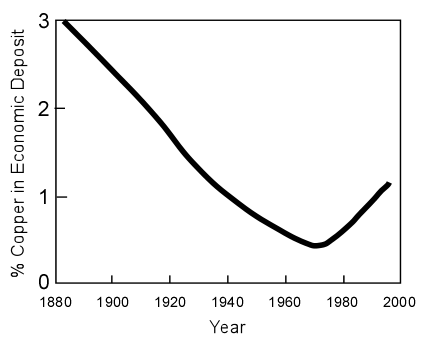Mineral Exploration and Production
Ores are located by evidence of metal enrichment. Geologists look for hints in rocks exposed near the surface, for example, the enrichment process often results in discoloration of the soil and rock. When such hints are found, geophysical survey's involving measuring gravity, magnetism, or radioactivity are conducted.
Geochemical surveys are conducted which analyze the composition of water, sediment, soil, rocks, and sometimes even plants and trees.
Once it is determined that a valuable material could be present, the deposit is assessed by conducting core drilling to collect subsurface samples, followed by chemical analysis of the samples to determine the grade of the ore If the samples show promise of being economic to mine, then plans are made to determine how it will me mined.
If the ore body is within 100 meters from the surface, open-pit mines, large excavations open to the air.are used to extract the ore before processing. Open pit mines are less expensive and less dangerous than tunnel mines, although they do leave large scars on the land surface. If the ore body is deeper, or narrowly dispersed within the non-ore bearing rock tunneling is necessary to extract the ore from underground mines. Mine tunnels are linked to a vertical shaft, called and adit. Ores are removed from the walls of the tunnels by drilling and blasting, with the excavated ores being hauled to the surface from processing. Underground mines are both more expensive and dangerous than open pit mines and still leave scares on the landscape where non-ore bearing rock is discarded as tailings. .
Global Mineral Needs
Because the processes that form ores operate on geologic time scales, the most economic mineral resources are essentially nonrenewable.New deposits cannot be generated in human timescales. But, as mentioned previously, as the reserves of materials become depleted it is possible to find other sources that are more costly to exploit. Furthermore, mineral resources are not evenly distributed.
Some countries are mineral-rich; some are mineral-poor.
This is a particular issue for strategic mineral resources. These strategic metals are those for which economical source do not exist in the U.S., must be imported from other potentially non-friendly nations, but are needed for highly specialized applications such as national security, defense, or aerospace applications. These metals include, Manganese, Cobalt, Platinum, and Chromium, all of which are stockpiled by the U.S. government in case supplies are cut off.
How long current mineral resources will last depends on consumption rates and reserve amounts.
Some mineral resources will run out soon, for example global resources of Pb, Zn, and Au? will likely run out in about 30 years. U.S. resources of Pt, Ni, Co, Mn, Cr less than 1 year. Thus, continued use of scarce minerals will require discovery of new sources, increase in price to make hard-to-obtain sources more profitable, increased efficiency, conservation, or recycling, substitution of new materials, or doing without.
Environmental Issues
Extraction and processing has large environmental impacts in terms of such things as air quality, surface water quality, groundwater quality, soils, vegetation, and aesthetics. Acid mine drainage is one example, Sulfide minerals newly exposed to Oxygen and water near the surface create sulfuric acid. Rainwater falling on the mine tailings becomes acidified and can create toxic conditions in the runoff. This can mobilize potentially dangerous heavy metals and kill organisms in the streams draining the tailings.
|

